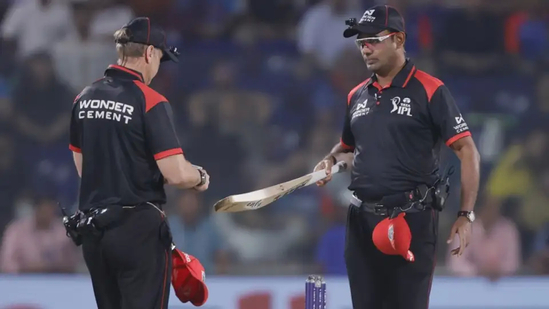The 2025 edition of the Indian Premier League (IPL) has added a new visual to the cricketing spectacle — umpires halting players mid-walk to inspect their bats. What started as sporadic checks has now been formalized as a standard operating procedure, with every batter required to undergo a bat gauge test before taking strike. This move, now officially explained by the BCCI, aims to ensure a level playing field and maintain the integrity of the sport.
Why Are Bat Checks Happening?
The trend caught widespread attention during Rajasthan Royals’ home clash with Royal Challengers Bengaluru. Star players like Shimron Hetmyer and Phil Salt were stopped by on-field officials and asked to slide their bats through a specially designed bat gauge. Only after passing the test were they allowed to resume play.
With the 2025 season already witnessing an avalanche of 200-plus scores and power-packed performances, the BCCI decided to introduce these random — now routine — checks to rule out any unfair advantage. IPL Chairman Arun Dhumal confirmed the new rule, stating:
“Nobody should feel that somebody’s got an undue advantage. The idea behind this initiative is to ensure that the spirit of the game is maintained.”
According to Dhumal, the umpires will possess bat gauges and are authorized to check every batter’s equipment before they face a single ball. Opening batters will be screened by the fourth umpire before entering the field, while incoming batters will be checked by on-field umpires.
What’s the Problem with the Bats?
At the center of the controversy is the alleged modification of bats to include more wood in the lower part — the sweet spot — of the blade. One international batter, speaking anonymously to The Indian Express, claimed:
“They bulk up the lower part of the bat since that is the area of the bat where the batsmen try to make contact with the ball. More wood around the sweet spot and less wood close to the handle gives more power to strokes.”
While these bats might not seem different to the naked eye, they can easily exceed ICC-specified limits. Here’s what the rules dictate:
Maximum width: 4.25 inches (10.8 cm)
Maximum depth: 2.64 inches (6.7 cm)
Maximum edge thickness: 1.56 inches (4.0 cm)
Handle length: Cannot exceed 52% of the bat’s total length
Covering material thickness: Limited to 0.04 inches (0.1 cm)
Toe protection thickness: Max 0.12 inches (0.3 cm)
Bat must pass the official bat gauge smoothly
A Shift from the Old Protocol
Previously, bat checks were conducted a day before the match. However, some players were found returning the next day with slightly different — often bulkier — bats. That discovery exposed a loophole, leading to the new, match-day protocol.
Now, real-time inspections help eliminate this manipulation. Though no immediate penalties are issued for non-compliant bats, players must swap them out on the spot. Persistent or deliberate breaches, however, can have serious consequences.
In fact, during the 2023 English County Championship, Essex was docked 12 points when batter Feroze Khushi was found using an illegal bat mid-innings — a costly mistake that impacted their standing.
Big Names Already Caught in the Act
While most players have passed the gauge test without issue, a few big names have had their moments of discomfort:
Hardik Pandya, captain of Mumbai Indians, had his bat checked during a match against Delhi Capitals but was cleared.
Sunil Narine, opening for Kolkata Knight Riders, faced an embarrassing moment when his bat failed the gauge test ahead of the match against Punjab Kings. He was forced to change it on the spot.
Anrich Nortje, Delhi Capitals’ speedster, also had to switch bats during a game, though his situation drew less attention.
These examples show that no player — regardless of stature — is above the rule.
A Step Towards Fair Play
The BCCI’s initiative has received praise for leveraging technology and enforcing standards to preserve the fairness of cricket. While some might view the checks as disruptive, most insiders agree it’s a small price to pay for upholding the sport’s integrity.
As IPL 2025 progresses, expect every batter to pause for a moment at the boundary line — not to adjust gloves or take a deep breath — but to ensure their bat passes the test. The bat gauge is here to stay, and it’s reshaping the way cricket handles equipment compliance.
In Conclusion
In a tournament where millimeters can separate boundaries from dot balls and the difference between a 180 and 210 total can define the game, the bat gauge isn’t just a tool — it’s a statement. A statement that fairness matters, and the BCCI is watching closely.
Whether it’s Hetmyer, Narine, or your next favorite debutant — every batter now starts their innings not just with a bat in hand, but with a stamp of approval from the umpire’s gauge.

